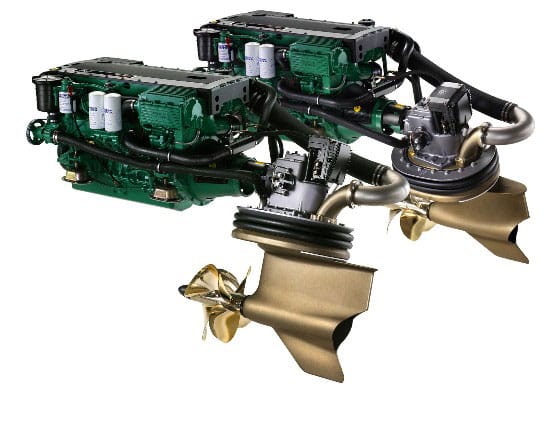Volvo Penta IPS began as an interesting invention but quickly turned into a product that revolutionized leisure boating — forever. Now, 10 years on, Volvo Penta IPS is available for almost any boat of any size and is still considered unique, offering comfort, performance and maneuverability currently unmatched by other systems. It is being celebrated at this year’s Southampton Boat Show, September 11 to 20.

In 2005 Volvo Penta made the impossible possible when it released its Inboard Performance System (IPS). To date, 540 boat builders have collectively used over 17,000 Volvo Penta IPS units to create around 1,100 boat models. Thousands of customers the world over are now enjoying the unique benefits of Volvo Penta IPS, which include extra onboard space and reduced noise and vibration levels. “Every year, new customers are being converted to ‘pod thinking’,” says Johan Wästeräng, vice president of product management at Volvo Penta. “Shaft drives work well, but Volvo Penta IPS is in a league of its own. Ease of use, additional onboard space and the product’s excellent track record are all reasons why more and more customers are using our Inboard Performance System.”
Changing boating forever
As soon as Volvo Penta IPS was launched, the benefits of forward-facing, twin counter-rotating propellers became apparent — handling, onboard comfort and performance were all improved compared to traditional inboard shafts. The propulsion efficiency of Volvo Penta IPS was enhanced by 35% during middle and top speeds (above 35 knots).

“Volvo Penta IPS really shook things up in the marine industry,” Wästeräng notes. “It moved the goal posts and made us think, ‘If we can do this, what other impossibilities can we make possible?’.”
The increased efficiency resulted in several other improvements that defined the launch of Volvo Penta IPS, including 30% lower fuel consumption. And, because of the position of the engine and transmission, there was often extra room in the hull for an additional cabin.
The new system’s improved efficiency also resulted in 20% higher top speeds. Reaching this level was previously very costly for a boat builder but, thanks to Volvo Penta, it was suddenly viable. Steering became more responsive, allowing for precise maneuverability, which was later enhanced by the introduction of joystick docking in 2006. Lower noise and vibration levels — facilitated by the rubber suspension — ensured a more comfortable ride.
Where it all began
“Volvo Penta’s journey to innovation began long before Volvo Penta IPS. We’re known in the marine industry for our innovativeness, thanks to releases like Aquamatic, Duoprop and the Saildrive,” explains Wästeräng. “Volvo Penta’s company ethos encourages exploration. We live like our customers — at one with water. We play with ideas until we happen upon something extraordinary; management understands that innovation is an organic process that takes time and patience. These are the secrets to our success.”
In the 1990s, the marine industry was facing a problem: boat builders were creating products that would offer their customers more inboard space, and they demanded an engine that would help these bigger boats reach higher speeds. To achieve higher speeds in a boat equipped with an inboard shaft, more power was required. More power could only be achieved by installing a bigger engine, but a bigger engine weighed more and would counteract any additional power created. To solve this catch-22 situation, Volvo Penta tested a large sterndrive, which it designed for use in bigger yachts.
“We realized that a bigger sterndrive option would face resistance in the market,” notes Wästeräng. “Sterndrives are seen as an option for boats, not big yachts, so instead we started looking into pod propulsion — we wanted to offer all the sterndrive Duoprop advantages to yacht owners.”
Design, development and testing began on the original Volvo Penta IPS prototype in 1997. While early models had fantastic acceleration and achieved impressive top speeds, they were not steerable — when the steering wheel was turned, the boat didn’t follow correctly and responsiveness was low.
Testing continued and soon several early generations of a hydraulically-steered pod system were created. However, following on from an incident with a broken hydraulic component, Volvo Penta swapped the unit’s hydraulic steering for an independent, electrically-steered unit. It was the first time in history that a boat was run without a mechanical, hydraulic connection between the steering wheel and the unit. This became an early version of the Volvo Penta IPS unit still used today. “Discovering that this worked was a complete breakthrough and totally revolutionary for our industry,” Wästeräng adds. “After much testing and other safety checks, the very first Volvo Penta IPS model was launched at the 2005 London Boat Show.”
Contact Volvo Penta









